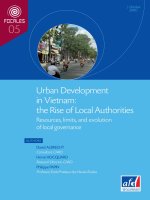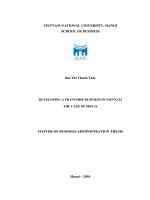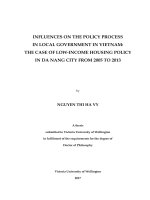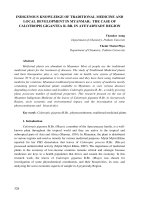Urban development in vietnam the rise of local authorities
Bạn đang xem bản rút gọn của tài liệu. Xem và tải ngay bản đầy đủ của tài liệu tại đây (1.45 MB, 143 trang )
05
05
FOCALES
October 2010
Urban Development
in Vietnam:
the Rise of Local Authorities
Resources, limits, and evolution
of local governance
FOC ALES
F O CAL ES
Urban Development in Vietnam: the Rise of Local Authorities
Urban Development in Vietnam:
the Rise of Local Authorities
Local authorities are playing an increasingly influential role in the exponential
economic growth and development of Vietnam and its cities. They have now
become key actors playing pivotal roles in the delivery of most public urban
services (water, sanitation, waste management, public transport, etc.).
This study provides a detailed analysis of how the Vietnamese local authorities
operate and how they manage the main urban public services. It examines their
roles, the limits of their powers, the institutional, financial and operational
instruments underpinning their action, as well as recent and future developments.
Based on an in-depth field study, this publication makes essential reading for
anyone interested in Vietnam’s urban development and who wishes to gain an
insight into the issues, risks and constraints involved.
[
October
2010
]
David ALBRECHT
Consultant, CARO
Hervé HOCQUARD
Research Director, CARO
Philippe PAPIN
Professor,
École Pratique des Hautes Études
AUTHORS
David ALBRECHT
Consultant, CARO
Hervé HOCQUARD
Research Director, CARO
Philippe PAPIN
Professor,
École Pratique des Hautes Études
CONTACT
Samuel LEFEVRE
Local Authorities and Urban Development Division, AFD
lefevres
@
afd.fr
AUTHORS
CouvFocalesN5(160x230)_Q_GB_BAT5 22/10/10 11:37 Page 1
Urban Development
in Vietnam:
the Rise of Local Authorities
Resources, limits, and evolution of local governance
AUTHORS
David ALBRECHT
Consultant, CARO
Hervé HOCQUARD
Research Director, CARO
Philippe PAPIN
Professor,
École Pratique des Hautes Études
Contact:
Samuel LEFEVRE
Local Authorities and Urban Development Division, AFD
lefevres
@
afd.fr
Publications Director:
Dov ZERAH
Editorial Director:
Robert PECCOUD
Photographic credits: Samuel LEFEVRE, AFD
Designed and produced by Ferrari /Corporate – Tel.: 33(1) 42 96 05 50 – J. Rouy/ Coquelicot
Printed in France by: STIN
[
Disclaimer
]
The analyses and conclusions presented in this document are the responsibility of the authors.
They do not necessarily reflect the position of Agence Française de Développement or its
partner institutions.
Focales
The Focales collection was launched in 2010 by AFD’s Research Department. It
aims to give accounts of the field experiences of AFD or its partners (experts,
researchers, consultants, practitioners ) in developing countries.
The publications in this collection present practical case studies (projects, experiments,
partnerships ) putting them into a broader perspective.They may also present
reflection on a sectoral or geographical issue which is always supported by concrete
results. They are intended to cover all the sectors and fields of action of AFD.
Already published in the collection:
Focales N
o
1 :
Accès de tous aux services d’eau : le rôle des petits opérateurs privés
à Hô Chi Minh Ville,Vietnam
Focales N
o
2 :
Le système de gouvernement local en Palestine
Focales N
o
3 : Linking Labour Organisation and Vocational Training in Uganda:
Lessons for Rural Poverty Reduction
Focales N
o
4 :
Financement des services d’eau en milieu urbain au Niger
All our publications are available at
Acknowledgements
The authors would like to thank the AFD Hanoi agency for its support during the course
of this study.
This publication is based on the final report of a research project entrusted by
Samuel LEFEVRE, a project manager at the Agence Française de Développement (AFD),
to a team of consultants (from the firm CARO) in order to furnish a comprehensive
overview of the local government sector in Vietnam: the context in which it operates,
its institutions, organisation, policies and the way in which these are implemented.
Since the 1990s, the city has become a pivotal element in the organisation of
Vietnamese society, on which the national economy is increasingly hinged. The rate
of urbanisation has risen from 16% in 1945 to close on 30% in 2009 and cities now
contribute to 70% to national production.
In the framework of its general orientations, which place partnerships with local
authorities and urban development high on the agenda, AFD wished to gain a deeper
understanding of how Vietnamese local actors operate and, more particularly, the role
they play in delivering the main urban public services (water, sanitation, waste man-
agement, public transport, health, education ). Hopefully, this study will enable AFD
to effectively tailor the partnerships it proposes to Vietnam’s local government actors
and to intervene in the most relevant way within the framework of its operations.
With this aim in view, an in-depth research study drawing on first-hand sources of
information was commissioned. In addition to an exhaustive review of the existing
literature, this required a great many interviews with national and local actors, mainly
in ten cities and provinces (including the five largest in the country) on which a
dedicated monograph has been produced (see Map 1, p.14). This research method
has enabled accurate and up-to-date information to be gathered from the actors
involved, which has added substantially to the depth and forcefulness of the study.
The research was conducted between July and November 2009 by Philippe PAPIN,
David ALBRECHT and Hervé HOCQUARD, the research director. Administrative
assistance was provided by Huong PAPIN. At the local level, the team was assisted by
several Vietnamese experts, interpreters and researchers, especially Mrs. NGUYEN
VU Phuong Lien, and by the researchers of the CEFURDS headed by Mrs. QUYNH
TRAN in Ho Chi Minh City. We would like to extend our warm thanks to all of them.
Nathalie LE DENMAT
Local Authorities and Urban Development Division, AFD
Foreword
3
© AFD / October 2010 / Urban Development in Vietnam: the Rise of Local Authorities
Table of Contents
Introduction 9
1. The Rise of the Provinces 13
1.1. The city, a mainspring of change in Vietnam today 13
1.2. How local authorities are organised 18
1.3. A budget still closely supervised and highly equalised
with the development of tools to support local action
25
1.4. The mechanisms for local public investment 35
2. Urban Development and Local Public Services 45
2.1. The forms of urban expansion 45
2.2. Urban spatial planning 51
2.3. Water production and supply 53
2.4. Sanitation 67
2.5. Waste management 76
2.6. Urban transport 89
2.7. Social housing 99
2.8. Health 110
2.9. Education 116
Conclusion 125
List of Acronyms 131
Bibliography 135
5
© AFD / October 2010 / Urban Development in Vietnam: the Rise of Local Authorities
Introduction
Introduction
[1]The economic opening up of the country was proclaimed in 1986 at the 6
th
Party Congress. It began in 1992, and
became effective with the suspension of the American embargo in 1994. The opening up was not a deliberate
political choice, but the consequence of a vital need. In a climate that had been marked by constant economic
depression since 1982-1983, the end of Soviet foreign aid acted as a trigger. Vietnam had been kept afloat by
this aid and, suddenly, in just a few months the support was withdrawn. The leaders urgently sought alternative
sources of aid: international aid, foreign companies, funds from the diaspora. It was only six or eight years later
that the idea of moving over from the recognition of free-market trade to actively promoting a market economy
took hold. Reforms were then extended to industry, trade, banks, state-run and foreign companies.
There are therefore two chronological periods that must be clearly distinguished so as to avoid any misunders-
tanding over the significance of
doi moi
and the way it was implemented. Indeed, if the two periods together
are seen as one, it is difficult to appreciate that the first period between 1986 and 1994—corresponding to a
forced opening that was intended to be temporary—had a considerable impact on the second period, which is
perhaps currently reaching completion.
Today, cities are the key drivers of Vietnam’s wealth creation, even though for many
years they also aroused a certain wariness that dates back to the struggles for inde-
pendence and reunification, which were chiefly supported by rural areas. Since the
turning point of the 1986 Renovation (
doi moi
),
[1]
policy cities have increasingly
become the major hubs of public action.
Local authorities play a key role on account of their regional roots, which give them
a specific legitimacy and responsibility among public actors. Their sphere of compe-
tence and autonomy
vis-à-vis
central government is constantly expanding, as are
their prerogatives and resources, although varyingly so depending on the economic
power of the territory they administer.
One of the overriding concerns of local officials is how to manage or support the
cities’ demographic and economic growth. They are required to act in an increasingly
complex local arena but must also rely on a central power that still holds real sway
even though this is wielded in a less and less systematic and preponderant manner.
The present study, conducted in 2009, takes stock of the emergence of the local
government administrations – with the provinces in the forefront – that have now
become the protagonists of economic and urban development. More specifically,
it provides a detailed view of the financial resources and mechanisms that local
governments have at their disposal in order to achieve their ambitions, despite the
ever-present supervision of central government. The study lays particular emphasis
on recent innovations in the ways that local government action is financed.
© AFD / October 2010 / Urban Development in Vietnam: the Rise of Local Authorities
9
Introduction
After an analysis of the paths of urban development in Vietnam and of the impact
of current public-sector planning tools, there follows a more detailed study of some
key public services that are the cornerstones of “sustainable” urban development:
drinking-water production and supply, sanitation, waste management and public
transport …
© AFD / October 2010 / Urban Development in Vietnam: the Rise of Local Authorities
10
Part One
13
© AFD / October 2010 / Urban Development in Vietnam: the Rise of Local Authorities
1. The Rise
of the Provinces
1.1. The city, a mainspring of change in Vietnam today
For about twenty years now, Vietnam has been initiating extremely rapid changes
which have completely transformed the country. These changes have been demo-
graphic, economic, social and even political, despite an apparent stability in terms of
discourse and a constant presence of the elites. Although it may not have been the
only engine, the city is the mainspring that best embodies this change.
1.1.1.
Demographic change
In 2009, Vietnam’s population stood at 85.8 million inhabitants, with an annual
growth rate in the region of 1.2%, meaning 1 million youths enter the labour market
every year. Cities, especially major cities, act as magnets for these populations which
do not find employment in rural areas.
The growth of cities is an extremely recent phenomenon in the history of Vietnam.
It initially mainly occurred in the South and was linked to the American period
(almost half of the inhabitants of Southern Vietnam were living in cities at the end of
the American War). Urban development was subsequently impeded by a Communist
regime that was somewhat wary towards cities and resorted to massive population
displacements. It only really began to take hold from the 1990s onwards.
Since this period, the city has become the main framework for the organisation of
society and the national economy. The proportion of urban dwellers rose from 18.5%
in 1980 (after the authoritarian ruralisation in the South
via
the displacement of
urban populations) to almost 30% in 2009, for a total population which rose from
53 to almost 86 million inhabitants over the same period,
i.e.
the urban population
was multiplied by 2.6 in less than 30 years. This increase went hand in hand with an even
faster physical expansion of cities. According to the Ministry of Construction, urban
areas in Vietnam represented 630 km
2
in 1995 and 1,380 km
2
in 2000 (multiplied by
2.2 in 5 years), with a forecast of 2,430 km
2
in 2010 (x 3.9 in 15 years) and 4,600 km
2
in 2020 (for a total land area of 341,690 km
2
).
14
© AFD / October 2010 / Urban Development in Vietnam: the Rise of Local Authorities
Demographic growth has particularly benefitted the urban areas on the two deltas,
the Central coast and in the Southeast. A part of the “temporary” migrants (who do
not have the status of permanent resident) are not included in official statistics. For
example, in Ho Chi Minh City, where the urban area now has 9 million inhabitants
(7.1 million in the city alone), it is estimated that at least 15% of the population is made
up of rural migrants that live in makeshift dwellings and are deprived of a legal status.
Part One
1
Map
Population density by province according
to the 2009 census
Map established on the basis of the 2009 census – GSO.
Chin a
Laos
Vietnam
Camb odia
Kilometre s
0 60 160 240 320
1:5000000
H
anoi
H
ANOI
CA N THO
HO CHI MINH CITY
BINH DUONG (capital THU DAU MOT)
KHAN HOA (capital NHA TRANG)
BINH DINH (capital QUI NHON)
DA NANG
NGHE AN (capital VINH)
HAIPHONG
LAO CAI
KEY
Pro
vinces and cities
in the study
Provincial boundaries
Density (inhab./km
2
)
classified by
Natural Breaks method
10-13
14-17
18-23
24-29
30-41
42-66
67-87
15
© AFD / October 2010 / Urban Development in Vietnam: the Rise of Local Authorities
This demographic change gives shape to an increasingly contrasting country: on the
one hand, rural and mountainous areas, deserted by youth, where the level of comfort
has seen practically no improvement (rural exodus: 1 to 1.5 million people a year);
on the other hand, cities which are constantly growing, with needs for housing and
collective services rising exponentially.
The metropolises are experiencing well above average growth, in the South with
Ho Chi Minh City and in the North with the capital Hanoi. Moreover, the admin-
istrative boundaries of cities no longer suffice to apprehend the issues relating to
their development. Major conurbations are, indeed, being formed, for example
around Ho Chi Minh City.
1.1.2.
Economic change
The average wealth of the Vietnamese has risen sharply over the past decades, with
income per capita reaching almost 800* in 2009, i.e. it has doubled in 12 years in
c
onstant currency and tripled in 20 years. This improvement in the standard of living
is also perceptible in the indices for equipment and access to collective services.
Urban dwellers are the main beneficiaries of this increase in wealth, or at least some
of them are, because cities concentrate the greatest social disparities.
The
doi moi
turning point, proclaimed in 1986 but effective in 1991, and the public
service “socialisation” policy,
[2]
unlike China, did not materialise in the destatisation
of the economy. In fact it was quite the reverse: the recent development of the
economy has come about by taking advantage of the framework of the State. Today,
the State sector accounts for over a third of GDP, half of investments and half of bank
credit, and for less than 10% of employment. Public sector companies are a corner-
stone of Vietnam’s economy and are active in all productive and service sectors.
They have specific accounting practices and their accounts are not consolidated
with any administrative level.
Agricultural activity is still the country’s main economic sector. It meets the needs of
a population which now eats to its fill and has a varied diet. It has also become an
exporting activity thanks to increased productivity. However, expropriations of farmers
linked to economic and urban expansion pose a threat: 2 million households lost
their land between 2000 and 2005 (more recent figures are not available). It is one
Part One
* 1 = 26,000 Vietnamese dong (2009).
[2] “Socialisa
tion” is the mobilisation of all components of society in order to participate in financing targeted sectors
(particularly public services), which notably means opening up to private capital and/or greater user participation.
16
© AFD / October 2010 / Urban Development in Vietnam: the Rise of Local Authorities
of the main causes of the current tensions in rural areas and generally involves the
most productive land in a country whose geography is constrained by mountains.
Industry has developed enormously. In this respect, Vietnam has not, however,
achieved the results of the other major countries in the region and industry employs
only 15% of the working population, primarily in state-owned or foreign enter-
prises. The centrally planned economy and the state-controlled environment, which
continue to persist, are not flexible enough to allow a powerful private productive
sector to fully develop. From this perspective, Vietnam is way behind China and the
Asian Tigers (Malaysia, Thailand ).
Generally speaking, imports continue to dominate in the country (machine tools,
raw materials, consumer products) and 60% of imports come from China. Although
Vietnam exports crude oil, it only has one refinery which was inaugurated in 2009,
and must import most of the refined products.
The informal economy is an essential dimension of the national economy and widely
contributes to its overall dynamism, thanks to its low cost and malleability. In Hanoi,
as in Ho Chi Minh City, it accounts for half of employment in trade, services, the
craft industry and small-scale industry. Part of this economy was officialised with the
2000 law on private companies, which also allowed the State to announce flattering
statistics on its market economy.
Despite its cumbersomeness and shortcomings, the economy is bolstered by annual
growth in the region of 7% and the recent crisis has caused only a slight slowdown.
The positive ingredients of this growth are the urban foothold, political stability, the
competitive advantage of low wages and a flexible workforce, a good level of basic
education (92.5% literacy rate) and a strong cultural aspiration for knowledge. To this
must be added a true feeling of national pride to see one’s country, free of all domi-
nation, now pull itself out of poverty.
The overheating of the economy became apparent in Vietnam as early as in the
spring of 2008, prior to the global crisis. Inflation (23% in 2008) and the trade
deficit caused a serious liquidity crisis, which obliged the country to resort to external
borrowing. An ambitious recovery programme – that came with a cost of a budget
deficit for 2009 estimated at roughly 8% of the gross domestic product – was
implemented. It resulted in sustained growth, along with a marked slowdown in
inflation.
Part One
17
© AFD / October 2010 / Urban Development in Vietnam: the Rise of Local Authorities
1.1.3.
Adjustment policies
A Western observer could well see the economic and political changes as being a
product of an astonishing schizophrenia.
●
On the one hand, the Party and the Communist order appear to be well
established. The ideological principles have not wavered, democratic centralism
continues to be the rule and, at all levels, State entities are coupled with
those of the Party. The economy continues to be centrally planned and the
performance of economic actors is theoretically subject to this planning. For
its part, the political discourse has remained close to the rhetoric of emulation
and voluntarism of yesteryear.
●
On the other hand, all the external signs of the liberal economy are on the rise,
with a more favourable legal environment (company law and contract law),
increasingly enterprising arrangements, aggressive behaviour on the part of
economic agents, a demand for performance and profitability, an emulation
and a greater freedom of initiative for the private or informal sector, an opening
up to foreign investors.
The distortions between these two worlds are obvious, as everything – or almost
everything – is agreed upon among those in power, under the undisputed authority of
the Party. It is the State and the Party, the latter controlling the former, that appoint
the leaders of the main levels of the political, administrative and economic hierarchy.
It is the State and the Party that will be in a position to ensure the country’s cohesion
and stability, despite the gap between the socialist discourse and the liberal practice
that often hits the people and the poorest. Current rural tensions (for example, the
clashes in Da-Nang in May 2010) give cause for concern in this respect.
The alliance of the “socialist tradition” and liberal modernism is organised through
numerous hybrid corporate structures that are gradually allowing public ownership
to give way to other interests. In order to bring about this change, state companies
consequently first acquired an identified and specific asset value, whose ownership
was subsequently opened up to private entities or individuals.
[3]
These entities are often very complex to analyse. The web of shareholdings in the
companies is impossible to untangle and it is generally impossible to identify the
private shareholders. Financial information is incomplete, difficult to obtain and
Part One
[3] Details on this point are given later in the section The Provincial “Holding Company”.
18
© AFD / October 2010 / Urban Development in Vietnam: the Rise of Local Authorities
questionable, because it is often based on local standards and is certified by non-
independent bodies. Decision-making processes are extremely discreet. Their mysteries
and protagonists are known and controlled by just a handful of individuals, comprising
men with political – and now financial – power.
This Vietnamese cocktail is subtle and effective. It is conciliatory regarding the past,
holds society firmly in the present and allows the new economy to develop. It is
obvious that this suits many people. The system may not be completely in line with
the moral doctrine and vision of the fathers of socialism, but it unquestionably
allows the country to take off.
1.2. How local authorities are organised
The local authorities play a key role in the evolution of the country, since the
material well-being of the inhabitants, particularly city dwellers, the way companies
are welcomed and the services they are offered, and the sound political management
of the country increasingly depend on them. Vietnam’s transformation has led to a
major change in the way they position themselves, with a move towards a clearly
marked strengthening of their prerogatives and their autonomy
vis-à-vis
the central
government, despite their formally subordinate status
vis-à-vis
the latter.
1.2.1.
How local public administrations are structured
From a legal perspective, local public administrations are just a dismemberment or a
local embodiment of the State. Their budget is simply part of the state budget and,
in principle, only serves to implement at the local level the plan defined at the
national level. In Vietnam, one can only consequently speak of devolution. At the
local level, the State is first embodied by the provinces, which are themselves
divided up into districts. Cities can be either provincial cities or district cities. They
are divided up into precincts (for the provincial cities) and wards. The rural districts
are made up of communes and villages. There are a total of 58 provinces and 5 cities
under national supervision (“provincial cities” of Ho Chi Minh City, Hanoi, Danang,
Hai-Phong, Can-Tho), which constitute the first local level of the administrative
system in Vietnam.
Part One
19
© AFD / October 2010 / Urban Development in Vietnam: the Rise of Local Authorities
The different levels of sub-national government cover extremely diverse realities
and show wide disparities. The role played by cities increases according to their
demographic and economic weight. They are involved in a sort of
cursus honorum
with a classification (in 6 classes), which their prerogatives and autonomy depend
on, as well as allocation conditions for development loans, for example. These six
classes are, in descending order, the “special” category (with only Ho Chi Minh City
and Hanoi), then classes I to V (cities in class I and II may be under national or
provincial supervision). The classification depends on quantitative factors (number
of inhabitants, urban dwellers, density ) and qualitative factors (influence of the city
from an economic, educational, cultural perspective ).
The province is the most important level, as it is in charge of the bulk of local public
services (public transport, infrastructure, health and education to a large extent,
water supply, sanitation, waste ), and generally confines the lower levels to
more narrowly local interventions. It also has a sort of supervisory authority over
their budgets and decisions. Cities thus generally have to defend their place and
autonomy
vis-à-vis
their province (except in the case of the five provincial cities under
national supervision). This results in perceptible conflicts, particularly in cases where
the city represents a large part of the provincial population.
Part One
1
Figure
The four levels of sub-national government
of the Vietnamese State
STAT E
PROVINCES
and provincial cities
districts/precincts/
or towns
wards/communes/villages
20
© AFD / October 2010 / Urban Development in Vietnam: the Rise of Local Authorities
The organisation of sub-national government is mainly based on the state model.
Departments in each of the provinces correspond to the main ministries (Finance,
Planning and Investment, Construction, Transport, Health, Education ).
[4]
These
departments report to both their ministry and the provincial authorities. These
authorities are organised as People’s Councils (the local legislature, linked to the
National Assembly) and People’s Committees (the local executive, under the super-
vision of the Government). The executive is, in reality, quite concentrated in the
hands of the Chairman of the People’s Committee and two or three other committee
members. This concentration of responsibilities within a restricted circle of people
is, moreover, a widespread practice at all political and administrative levels.
Part One
2
Figure
Authorities and levels of administration
Party
PROVINCECITY
DISTRICT
National Assembly
People’s CouncilParty People’s Committee
People’s Council
Party
People’s Committee
People’s CouncilParty People’s Committee
Government
Permanent Committee
Central Committee
Political Bureau
Part
y
General Secretary
Committee
Permanent Committee
Chairman
Comité
Permanent Committee
Committee
Chairman
Comité
Permanent Committee
Committee
Chairman
Comité
Permanent Committee
Council
Chairman
Comité
Permanent Committee
Council
Chairman
Council
Permanent Committee
Chairman
Secretary
Prime Minister
Permanent Committee
Committee
Secretary
Permanent Committee
Committee
Secretary
Permanent Committee
Committee
[4 ] For example, the Ministry of Finance corresponds to the provincial Department of Finance in the province: the
Ministry of Construction corresponds to the provincial Department of Construction in the province and also
at the district level, etc.
21
© AFD / October 2010 / Urban Development in Vietnam: the Rise of Local Authorities
The local administration operates with weak inter-department collaboration and an
apparently rather lax coordination on the part of the Chairman of the People’s
Committee. This coordination is organically exercised by the provincial Department
of Planning and Investment for investments and by the provincial Department of
Finance for budget preparation and execution. The other departments appear to be
quite widely autonomous in their mission, meaning there are sometimes delays and
conflicts. In addition, management tools and information-sharing appear to be
underdeveloped and rarely computerised.
On the periphery of the provinces, public sector companies and other “ancillary”
entities play an increasingly important role (see below).
1.2.2.
Politico-administrative integration
The Communist Party and the Fatherland Front are less visible – but of course
essential – actors. All important decisions are taken with the approval or according
to the directives of the Party. Their local leaders have real power, which is often
greater than the visible power of the province or city leaders themselves. The Party
has also shifted from an organisation based on a handful of elites to a much more
systematic network within society, in order to ensure it is firmly established. The
Fatherland Front, which groups together all the active social forces, sectoral and
professional organisations is a valuable representative and intermediary for the
Party. It plays an essential role in appointing candidates to the different political
functions. This whole system exercises an effective control over society, along with
a power of leadership which is omnipresent and very real.
There is a great osmosis between leaders at both the local and national levels. In the
cities and provinces, all the senior positions are held by members of the local branch
of the Party. Recent institutional changes have led to a move towards a public display of
the leadership role of the Party and a simplification: People’s Councils are being
abolished and the positions of Party Secretary and Chairman of the People’s Committee
have been merged. Since the beginning of 2010, these positions are systematically
combined. Communes and districts in about ten provinces are already operating under
this regime. This osmosis also exists among the other main bodies (army, police),
which are, moreover, also represented on the People’s Committees. This practice
cements the pact of local governance and, at the same time, ensures it is opaque
and allows the parties involved to agree on the sharing of the benefits of growth.
In short, the centre of local power lies within the Party, whose local leadership is
increasingly merged with that of the People’s Committee.
Part One
22
© AFD / October 2010 / Urban Development in Vietnam: the Rise of Local Authorities
1.2.3.
Increasing local autonomy
Over the past years, one can observe an unquestionable trend towards a greater
autonomy of local authorities, particularly the provinces. Recent texts confirm this
trend:
●
Decree 12/2009 of 10th February 2009 on public investment, whereby only
the most important cases are subject to the agreement of the central level;
●
Law 30/2009/QH12 of 17th June 2009 on urban planning, which gives a
greater latitude to local governments for the definition of zoning and building
regulations;
●
various laws and decrees passed in 2007 in the sectors of water (Decree
117/2007/ND-CP of 11/07/2007), sanitation (Decree 88/2007/ND-CP of 2007),
waste (Decree 59/2007/ND-CP of 2007), which specify and extend the
prerogatives of the provinces;
●
the creation of investment funds (at the end of the 1990s, but this has gained
importance since Decree 138 of August 2007), which provide the provinces
with a financial instrument for their operations.
Almost everywhere, the “horizontal” hierarchy of the provincial committees over
the local departments prevails over the vertical hierarchy of ministries over these
departments, except when the important nature of decisions means they still
require central approval, particularly when transferred credits are at stake (which is much
more generally the case in the poor and rural provinces than in the economically
dynamic and urban provinces).
This evolution meets a unanimously recognised need. The State has implicitly
relinquished ruling over everything in the face of the increasing complexity of
society. There are too many decisions to be made and too much information to
handle. It recognises that the local level is often in a better position to take decisions,
and the latter consequently increasingly benefits from a kind of delegation. The fate
reserved for the Plan (Socio-Economic Development Plan – SEDP), which appears to be
mainly a national “exercise in style”, is one example of this. The most important thing
would appear to be to formally comply with the SEDP and provide evidence of this.
The corollary of this is a form of pressure from the central level, which is exerted in
a more or less formal manner on local authorities. They are openly requested (as
one can see in the press) – at least in the cities – to have more and more effective
public services, plentiful housing and high-quality infrastructure. They must also
Part One
23
© AFD / October 2010 / Urban Development in Vietnam: the Rise of Local Authorities
conduct the major development projects with diplomacy. Popular satisfaction and
social peace in the provinces are indicators of success that are carefully measured by
the upper echelon of political hierarchy. Local leaders abide by this and in return ask
the State to give them complete freedom
There is, in addition to this pressure, a form of competition between provinces. Provincial
leaders are consequently extremely sensitive to the Provincial Competitiveness Index
(PCI),*established annually for each province by American and Vietnamese experts,
on the basis of about ten representative criteria of the dynamism of the province,
the administrative effectiveness and its integrity. This ranking is taken very seriously by
the central authorities and moving up a few places is an envied sign of major success.
Part One
*









